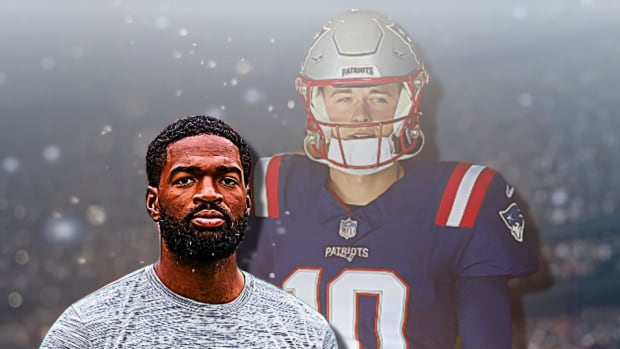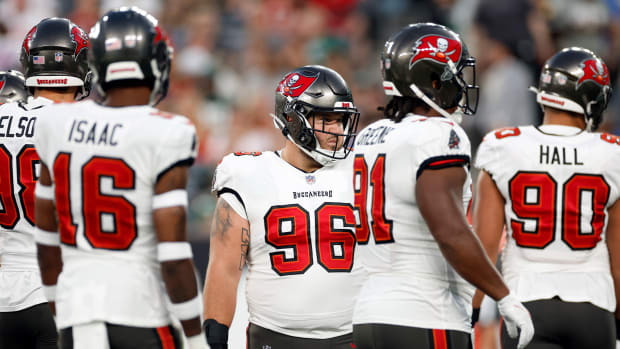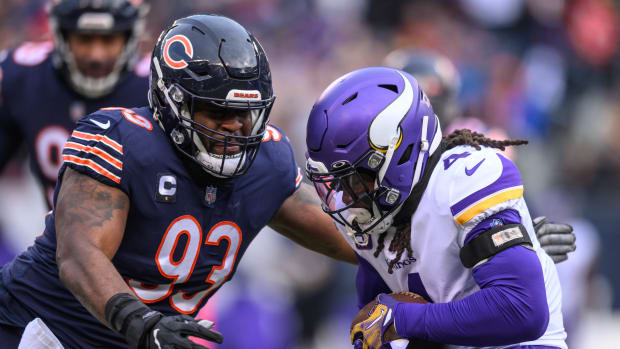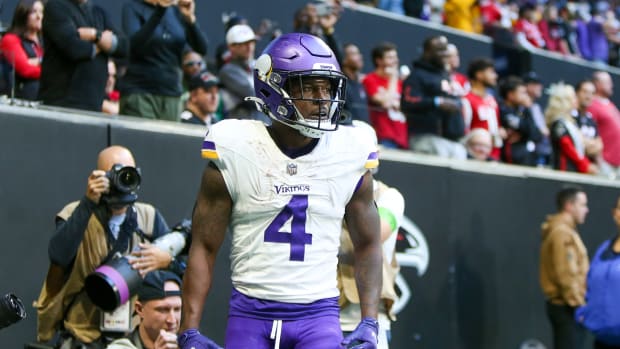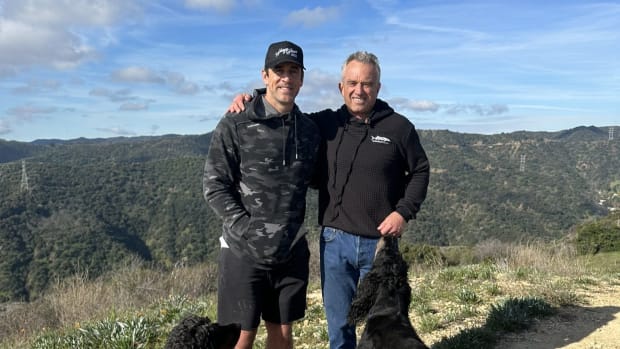Digging into the NFL’s Turkey Day Games
Lions Offense vs. Vikings Defense
These teams met earlier this month, which the Lions won in overtime. Detroit’s up-and-down O-line, facing a strangely struggling Vikings front four, had one of its “up” weeks, keeping the offense on schedule for much of the afternoon. That proved critical, as Lions receivers had trouble getting consistent separation against Minnesota’s stingy secondary. The one man who did give the Vikings trouble was Eric Ebron. The third-year tight end is gradually becoming a more flexible receiver, both in terms of where he lines up and what routes he runs. Ebron hurt the Vikings badly down the stretch on in-breaking patterns. Included in this was a 23-yarder to convert third-and-3 in overtime, beating safety Harrison Smith. Smith, as of late, has assumed more man-to-man assignments after long being the free defender in most of Minnesota’s matchup coverages. The Ebron conversion wasn’t the only lump Smith took; along with Xavier Rhodes, he gave up the completion and missed the tackle on Golden Tate’s game-winning 28-yard touchdown. Still, the Vikings should be comfortable with Smith matching up in this one. There are worse things than counting on your top defensive veteran to bounce back. Even when it’s not man coverage, Smith will often be facing Ebron. The Lions like 2 x 2 formations with Ebron flexed just off the line of scrimmage. The Vikings like to play Quarters coverage out of their two-high safety looks, with Smith defending one of the seams. When Ebron’s route takes him more than eight or so yards downfield, Smith will often be the defender he has to beat.
Advantage: Vikings
Vikings Offense vs. Lions Defense
Like the Vikings, the Lions also play a lot of two-high safety coverages. Defensive coordinator Teryl Austin is big on stopping the run with just seven men in the box. He shouldn’t have much trouble doing that against a Vikings ground game that is averaging 2.7 yards an attempt, the lowest in the NFL since the 1970 merger. Detroit’s run D was solid in the last meeting, which was also Pat Shurmur’s debut as Minnesota’s offensive coordinator. Shurmur did a superb job crafting route combinations that exploited those two-deep coverages underneath. That meant quicker passes, which hid Minnesota’s reeling offensive line. You can bet the Vikings will play this way again for the simple reason that they have no choice. Offensive tackles Jeremiah Sirles and T.J. Clemmings can’t be left on the island that deep dropbacks create.
Route combinations are something defenders can adjust to after playing against it once and studying it more on film. Let’s assume Detroit’s linebackers, wiser now in Round 2 against this offense, stop a handful of Minnesota’s shorter passes, creating some additional third-and-longs. What happens then? When these scenarios came up last time, the Lions often ran twists and stunts as part of a five-man blitz. Their key guy here is Ziggy Ansah. He has no sacks this season, but he’s been very disruptive on stunts, particularly out of a roving standup position, looping around two defenders (as opposed to just the usual one). At the very least, Ansah’s lanky frame can obstruct a quarterback’s vision when he loops up the middle.
Advantage: Lions
* * *
Cowboys Offense vs. Washington Defense
It was a different world when these teams met back in Week 2. Washington, now a mixed-coverage D, was playing zone on almost every snap and Josh Norman, to pretty much everyone’s consternation, was staying on the left side of the field rather than traveling with guys like Dez Bryant. For Dallas, the offensive line had not yet located its zone blocking rhythm, and Ezekiel Elliott was enduring some short-lived early growing pains as he adjusted to the speed of the NFL. In Elliott’s case, he had to go slower, not faster, and give his blocks a better chance to materialize. After he fumbled twice down the stretch against Washington, some Dallas radio shows actually discussed whether the rookie needed to be benched for Alfred Morris. (It’s OK to laugh now.)
That Week 2 game, of course, was also just Dak Prescott’s second in the NFL. He could have posted bigger numbers if not for pass rushing pressure that hid coverage breakdowns in Washington’s secondary. Spearheading that pressure was Ryan Kerrigan, working against right tackle Doug Free. To some, Free can look like a liability because he’s a so-so athlete playing alongside three superstar blockers (Tyron Smith, Travis Frederick and Zack Martin). But Free is an above average NFL right tackle, and he’s seen plenty of Kerrigan before. If he can keep the long-armed bull-rusher at bay, we’ll watch an excellent battle between Washington’s defensive backs and Dallas’s receivers. Norman struggles against quick speedsters, but that’s not Bryant’s game. Washington also has a lot of coverage flexibility at safety, namely with converted corner Will Blackmon and improving second-round rookie Su’a Cravens. Those two can double Jason Witten if coordinator Joe Barry is willing to gamble with smart but athletically capped linebacker Will Compton taking Elliott in the flats. The alternative is defending Witten with Donte Whitner, who has struggled lately in coverage. That’s part of the reason Washington has given up 27 catches and 318 yards to tight ends over its last three outings.
Advantage: Dallas
Washington Offense vs. Cowboys Defense
Washington’s offense is red hot. It’s imperative that Cowboys defensive coordinator Rod Marinelli change things up from snap to snap. Marinelli has long been a zone-based play-caller. Prepping on a short week, there’s a strong temptation to keep things simple and go with what you know best.
That’s unwise in this case, however. Washington’s staff over the years has had a great feel for Marinelli’s zone coverage principles, and they’ve often burned them with clever formations that align receivers in perfect locations to create deep shots downfield.
The Cowboys defensive line plays with great energy (Marinelli’s men always do), but it is not explosive enough to compensate in situations where Washington has Dallas’s coverage figured out. Especially not with how well Washington’s O-line is playing right now. And so Marinelli needs to avoid having identifiable play-calling patterns. Make Kirk Cousins have to diagnose the coverage, not confirm it.
Stopping the run goes a long way toward being unpredictable. It’s much easier to change things up on third-and-long. Washington’s ground game will feature zone carries behind three line-of-scrimmage-tight ends. That creates a lot of gaps for the defense to handle. Dallas might be the best in the league at disrupting gaps by slanting the entire D-line in one direction and letting linebackers Sean Lee and Anthony Hitchens scrape to the other. But the Cowboys learned in their second meeting with Washington last season that this, too, can become predictable and exploitable if not done with down-to-down diversity. Which brings us full circle to the original point, which is worth hammering home yet again: tactically, the Cowboys must change things up as much as possible.
Advantage: Washington
* * *
Colts Offense vs. Steelers Defense
Likely no Andrew Luck in this one, which gives Steelers defensive coordinator Keith Butler all the more reason to blitz. After playing a lot of conservative zone coverages early in the season, Butler has steadily dialed up more pressure in recent weeks. Most likely he trusts his young secondary more. Indy’s backup quarterback Scott Tolzien hasn’t started a game since 2013. Now he’s starting on a short week. And he’s doing so behind a mediocre offensive line that has had trouble against stunts and twists, particularly up the middle. This line did, however, mostly handle those tactics well against the Titans last week. That Titans’ D, coordinated by longtime Steelers defensive czar Dick LeBeau, employs a lot of the same pressure concepts as Butler’s Steelers (Butler worked under LeBeau for many years). And while the Titans have significantly better front line pass rushers than the Steelers, they don’t have explosive downhill attacking linebackers like Ryan Shazier and Lawrence Timmons. Both men were spectacular last week at Cleveland, often taking turns rushing the passer while the other dropped into coverage.
If and when the Steelers blitz, Tolzien must be on high alert for pressure coming off the slot. And when he sees this, he must resist the temptation to throw quickly to that “now uncovered” slot receiver. One of Butler’s favorite tactics is to roll trap coverages behind slot blitzes. This is especially true when he’s facing a team with a clear go-to target. Indy’s go-to guy, T.Y. Hilton, often aligns in the slot in obvious passing situations.
Advantage: Steelers
Steelers Offense vs. Colts Defense
Indy’s D has not yet seen a player like Le’Veon Bell. (Mainly because other ones don’t exist.) Most defenses account for Bell in the running game with their linebackers. When he splits to the slot or even out wide in Pittsburgh’s dangerous spread passing game, they guard him with a safety. Linebacker and safety are Indy’s two most vulnerable positions (which is part of the reason Chuck Pagano and defensive coordinator Ted Monachino have often rotated players here). The more Pittsburgh does with Bell, the more stress they’ll put on Indy’s mediocre interior defense.
The other guy who stresses a defense, of course, is Antonio Brown. Vontae Davis doesn’t travel with No. 1 receivers inside, but he’ll travel with them on the perimeter. The Steelers this year have kept Brown outside more than you might guess, particularly out of their trips formations, where he often aligns by himself on the weak side. Stylistically, Davis presents an intriguing matchup against Brown. The eighth-year corner’s physicality can prevent Brown from getting into his routes on time and creating space at the top on his breaks. Yes, Brown is still dangerous even when the route isn’t executed on time (maybe you’ve noticed that he and Ben Roethlisberger have some chemistry when plays break down). But he’s absolutely lethal when the offense is humming in rhythm. To establish rhythm when none is presenting itself, Roethlisberger likes to hit Brown on screen passes. Here Davis is an intriguing matchup again, as he’s one of the best open space tackling corners in football.
Advantage: Steelers
• Question? Comment? Story idea? Let us know at talkback@themmqb.com

































